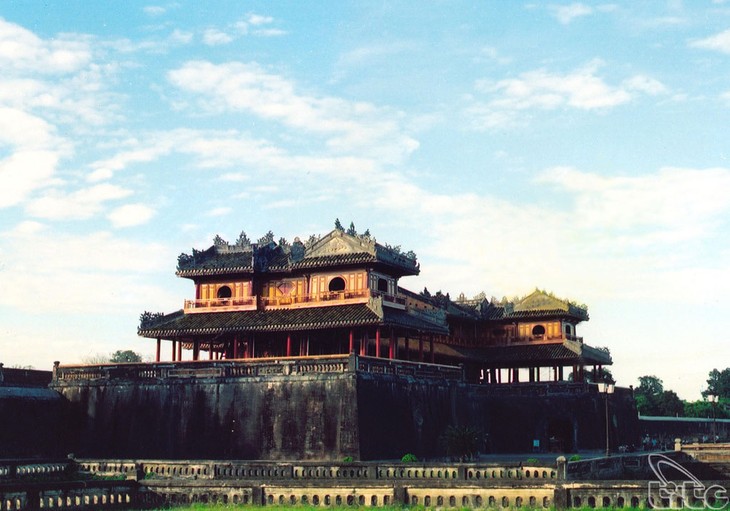(VOVworld)- The Imperial Citadel of Hue, a UNESCO cultural heritage is a major tourist destination in Vietnam. Its construction began in 1805 in the reign of King Gia Long, founder of the Nguyen Dynasty and ended in 1832 in the reign of King Minh Mang. 200 years have passed but the imperial citadel with nearly 140 buildings still remains almost intact.
Built along the Perfume River, Hue citadel is a huge complex covering an area of 520ha and comprising three circles of ramparts, Kinh Thành Huế (Hue Capital Citadel), Hoàng Thành (Royal Citadel) and Tử Cấm Thành (Forbidden Citadel). The Hue citadel is surrounded by 7 km of river that protected and served as a waterway for the citadel. The complex was designed in accordance with Eastern philosophy, Vietnamese tradition and Western architectural influence. Nguyen Thi Khanh Ha is a guide with the Open Tour Travel Company: "Hue citadel faces Ngự Bình mountain, with the Perfume river as its front hall and two sand dunes, Cổn Hến and Cổn Dã Viên, representing the Green Dragon on the left and the White Tiger on the right protecting the citadel. The citadel looks toward the south with the implication that the King turned to the south to rule the country”.

The area of the citadel is in a square shape with a perimeter of 10 km, each side of the citadel is about 2.5 km. The whole structure is built around a main axis. Khanh Ha explains:"The construction respected the principle of balance between Yin and Yang , that is to say, male and female , but also the balance between left and right. The aim was to ensure the continuity of the dynasty. If there is a bell on the left, there must be a drum on the right."
Inside the Capital Citadel is the Imperial City, where the most important agencies of the monarchy and shrines dedicated to the kings were located. The Royal City comprises more than 100 buildings of beautiful architectural styles scattered in different areas. It has four main gates. The south gate (Ngo Mon) was reserved exclusively for the emperor. Khanh Ha says:“From the south gate (Ngọ Môn) to Thái Hòa Palace was an area used for major ceremonies of the Royal Court. Sanctuaries called Triệu Miếu, Thái Miếu, Hưng Miếu, Thế Miếu and Phụng Tiên are dedicated to the worship of the Nguyen kings. Deposed kings are not worshiped here. Inside the Thế Miếu sanctuary, 10 altars are arrayed. The middle one is the most important one. It is dedicated to the worship of King Gia Long, founder of the Nguyen Dynasty”.
Inside Thế Miếu sanctuary are Vietnam’s 9 largest dynastic urns, each dedicated to one King of the Nguyen dynasty. These urns are intricately carved with patterns and designs depicting the beauty of Vietnam.
Behind Thái Hòa Palace is the Forbidden Purple City or Tử Cấm Thành, where visitors can learn about the lives of the royal family and mandarins. The Forbidden City has large buildings with magnificent architecture and intricate decorations. Ms Khanh Ha again:"At the heart of the Forbidden City is a large palace called Khôn Thái. It was built in 1804 in the reign of King Gia Long. Nearby are the Cần Chánh palace where the King worked and the Càn Thanh palace, where the King rested."
If you visit Hue, you absolutely must visit the majestic tombs of the Nguyen kings that lie west of the Imperial Citadel. Set amidst hills, along the Perfume River, the royal tombs are typical works of Vietnamese architectural arts. Each reflects the views of the emperor but also his personality and taste. Much less picturesque than the Imperial Palaces, the tombs give visitors a sensation of being in nature.
A day is long enough to visit the Imperial Citadel and several royal tombs, but not long enough to discover the many other relics and sites that recall life here about 200 years ago. If you love cultural discoveries, feel free to spend more time. In Hue, you will be rewarded!